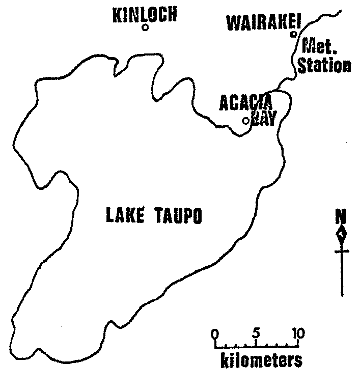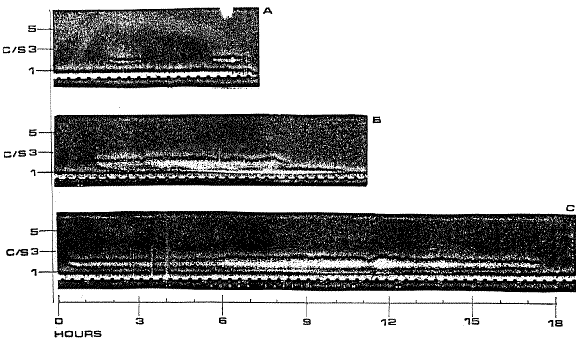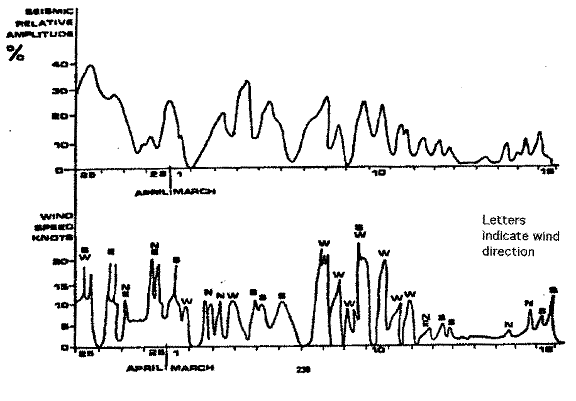|
APPENDIX III
LOCAL LAKE MICROSEISMS RECORDED
NEAR LAKE TAUPO IN THE NORTH
ISLAND OF NEW ZEALAND
GRESHAM.R.T.CIACY
ABSTRACT
Microseisms associated with winds blowing across a lake,
appear as ground noise in the range 1 - 2.5 c/s. These
transient "Lake Microseisms" obscure the true geothermal
ground noise.
INTRODUCTION
Geothermal ground noise surveys can be adversely influenced
by transient seismic phenomenon. Microselsms occurring from
lakes produce major transients that may be difficult to
identify without sufficient record. This paper is based upon
observations made upon the shores of Lake Taupo, North Wand,
New Zealand in 1966. The same seismoniter tape recorder unit
sited at kinloch, about 3.2 Kilometres from the lake shore,
and later at Acacia Bay. about 800 metres from the lake
shore (Figure M. local microseisms were recorded at both
sites. An analysis of these events and a comparison with
meteorological data from the Wairakei Meteorological
Observatory show that these microseisms were closely related
to the magnitude of the wind.
DISCUSSION
Records taken during the period 25 February to 19 March 1966
at the Kinloch and Acacia Bay sites were studied, and chart
records of the overall amplitude in the frequency range 0.1
cps to 15 cps were plotted and frequency analysed. The
frequency spectrum analysis samples (Figure 2) of which many
were made, all showed a very much higher amplitude than the
geothermal ground noise. These varied in length from 1 hour
to 18 hours, which was the longest wind storm recorded
during this study, and coincided with the meteorological
data of the wind storms.
The frequency spectrum and the average amplitude of the
local microseisms were not greatly influenced by the
direction of the wind, although microseisms with low
frequencies were always accompanied by winds from the South.
Frequency spectrum, average amplitude. and duration of the
microseisms showed a relationship with the wind speed. For
example, seismic disturbances of short duration with
frequencies of around 2.0 c/s (Hz) were in most cases
accompanied by winds, with speeds less than 5 knots.
Microseismic events which lasted longer than three hours
with frequencies between 1.0 and 2.5 cps were in each case
accompanied by winds with speeds greater than 10 knots. At
the onset of the microseism higher frequencies are dominant;
lower dominant frequencies occur later. The time lag between
the beginning of the microseismic disturbance and the
occurrence of the lowest frequencies in the frequency
spectrum (around 1.2 cps) is about 3 to 6 hours. A
peculiarity in the spectra is that signals with a frequency
of about 1. 5 cps are low in energy.
Published in "The Geothermal World Directory" 1973. Page
56.
A relationship between average amplitude of the microseism
and average wind speed is indicated. (Figure 3) especially
during the period 8 to 18 March, 1966. but peaks of high
winds do not always correspond with peaks in the average
high microseism ground noise. Volcanic, earthquake. and man
made noise can be recognized by vertical noise columns in
(Figure 2a, b, and c). The persistent horizontal less
dominant lines represent geothermal ground noise. (Figure 3)
compares the recorded noise levels in the frequency range
0.1 to 15 cps and meteorological data. This noise includes.
besides local events, microseisms generated by the ocean
(frequencies below 1 cps).
CONCLUSIONS
The comparlson between stations suggests, that more than
wave action on the shore is responsible for the lake
microseisms. Winds from the South produce lower frequencies
possibly because the Wind has to cross the lake with
consequent longer wave actions, whereas winds from other
directions start closer to where the seismic stations are
located. North of the lake. The onset action on the water
has to be considered. It appears to produce the observed
higher frequencies for all but the South winds. especially
during the earlier part of the wind storms. To accurately
identify this phenomenon and to insure a correct
identification of true geothermal ground noise; it would
appear essential to record by the direction of the wind,
although microseisms before and after, as well as during,
the wind Storms.
FOOTNOTE
The conclusions drawn have been corroborated by proprietary
surveys in the vicinity of Lago de Chopala Mexico, when the
author was with the University of Mexico. Lago, de Chopala
has the same surface area as Lake Taupo in New Zealand.
There have also been recorded wind microseisms several days
long generated by the Great Salt Lake in Utah, and also in
the Salton Sea California, as well as other lakes in the
U.S.A.
GEOTHERMAL WORLD DIRECTORY 1973 PAM 5 6
NOTE Using the listening technique., the wind microseisms
were easy to identity. Then they could be excluded from the
seismic tremor. Ocean microseisms am much lower frequency
and out of the seismic tremor range. It is worth noting that
the record when played back sounded like the doppler effect.
Another good reason for using the listening technique.

FIGURE 3 Relative amplitude of microseisms at Kinloch. Wind
speed in knots at Wairakei, from the 25th of February to
18th of March 1966

FIGURE 1. Map showing location of Lake Taupo, North Island
New Zealand, and location of Seismic Station and
Meteorological station.
FIGURE 2 Frequency analysis of three microseisms recorded at
Kinloch between 26th February and 19th March, 1966.

White represents the seismic signal. The white below the
1c/s level is very low frequency . Using the listening
technique, these phenomena sound like the doppler effect,
which identifies these events easily.
Go to
Download page
for seismic audio files and
discussion by G.R.T. Clacy
Return to main
page
|